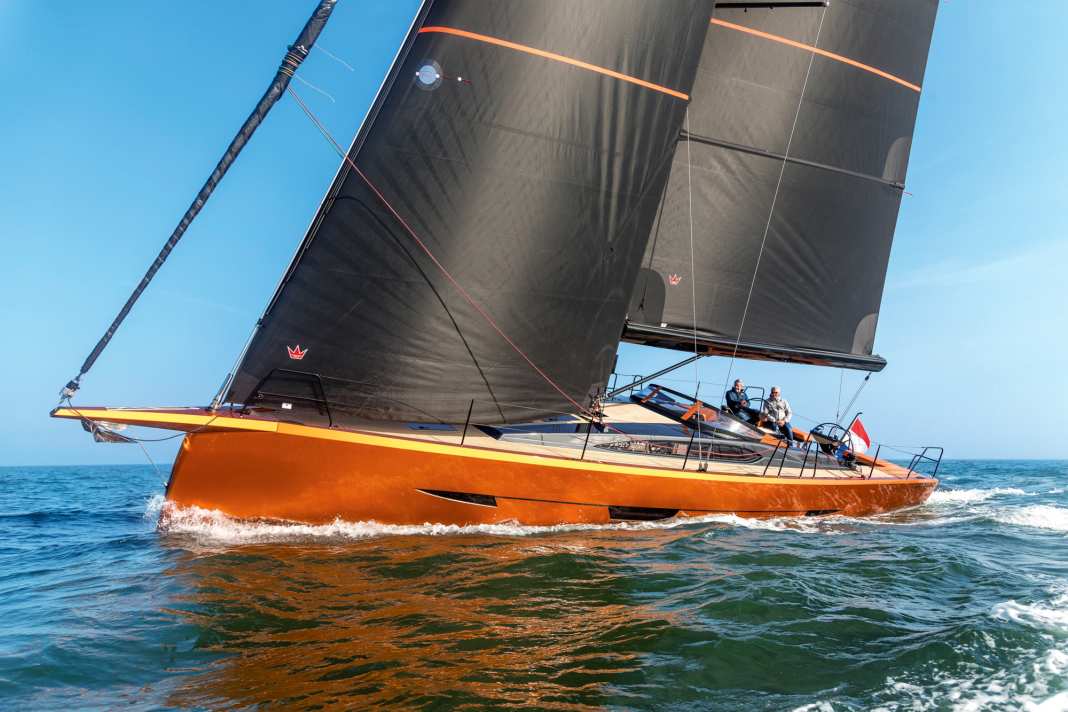





The Dutch company Saffier Yachts has become known for its jaw-dropping surprises. The busy yacht builders in IJmuiden on the North Sea have repeatedly made a name for themselves in recent years and decades with exciting and extremely innovative new construction projects. With no fewer than five European Yacht of the Year awards to its name, the brand is also one of the most successful regulars in the competition for the yacht building industry's most important award.
Read more about the shipyard:
So far, the Dutch have centred everything around daysailers and weekenders. It is therefore not without good reason that the Saffier is often cited as a reference for smaller boats of this type. No other manufacturer has had such a strong influence on developments in these market segments in recent times and driven them forward with new models. This made the shipyard's announcement a year ago that it was finally planning to build a larger boat, the Saffier SL 46, all the more exciting. The suffix "SL" stands for the new Saffier Luxury shipyard line.
With this project, shipyard bosses Dennis and Dean Hennevanger are now venturing out of their successful comfort zone and taking on new challenges in a completely different competitive environment. This shows courage and entrepreneurial spirit. The only question is: why?
Unmistakable brand identity
Shipyard boss Dennis Hennevanger explains: "My brother Dean and I have always wanted to build a much larger ship. Until now, however, we didn't have the means to do so. It was only with the construction of the new production facility in IJmuiden that we were finally able to realise this wish." The shipyard's brand strategy is probably also a factor. With the expanded programme, Saffier now wants to further bind those customers to the brand who want to upgrade to a larger boat at a later date. The Dutch company has had to let this clientele go in the past.
However, the shipyard bosses find it difficult to categorise their new flagship in a specific competitive environment. "The concept is unique and therefore not comparable with other yachts of the same size," says Dennis Hennevanger. The best way to categorise it is as follows: The boat is both a sleek fast cruiser and a cosy weekender - just in an upmarket XXL format.
In fact, the concept and design borrows numerous elements from the existing shipyard programme of smaller boats, particularly from the young Elegance line. The flat cabin superstructure with the brand-typical windscreen and the rather conservative, but all the more attractive hull lines speak in favour of this. On top of this, the spacious and comfort-orientated cockpit with its uncluttered layout and the high and powerful sail plan with the long bowsprit ensure unmistakable brand identity.
XXL daysailer, cruising boat or performance cruiser? The boat does not allow a clear categorisation.
Test under sail
The new Saffier is available in two versions. The Med version (stands for Mediterranean) has an open aft cockpit. The two seats for the helmsman can be moved lengthways as required and as desired, allowing flexible use of the spacious aft deck as a platform for sunbathing and relaxing. The North version, on the other hand, has a completely enclosed stern, making it a centre cockpit yacht. This version offers the advantage of a large dinghy garage in the aft area, in which a small inflatable boat can be stowed crossways. However, this does not make the boat a designated blue water yacht. The Hennevangers never really pursued this claim with their ambitious concept. Incidentally, Saffier has already sold six SL 46 boats, all in the Med version.
The YACHT test takes place in the best conditions with up to force four winds on the North Sea off IJmuiden. It couldn't have been better. Hard on the wind, the SL 46 reaches a speed of 7.1 knots at an angle to the true wind of just under 40 degrees. Steering the large Saffier upwind is a real pleasure. The moderate rudder pressure provides welcome feedback and makes it easy to bring the boat up to its full performance potential.
Measured values of the Saffier SL 46





It is surprising how quickly the Saffier reacts to the movements of the steering wheels. In order to maintain the dynamic sailing characteristics even on the deeper courses, we recommend using a Code Zero, which is attached to the 1.20 metre long, solidly constructed bowsprit at the very front, where it works efficiently. At half wind, the log can reach the ten-knot mark.
You can also stay on the boat for longer. The interior is cosy and there is nothing missing for the tour.
The good performance is supported by the very high-quality equipment of the test boat with the construction number one. The boat has a carbon fibre rig from Seldén instead of the standard aluminium mast from the same manufacturer. In addition, there are the good membrane sails with EPEX technology from Elvström, which Staffier already supplies in the standard basic package. Rod shrouds are attached in both versions - also straight from the shipyard. As an alternative to the self-tacking jib, an overlapping genoa with line-adjustable hove-to points would also be feasible.
Well thought-out and complete - nothing is missing on deck
What's more, construction number one is equipped with an unusually comprehensive push-button package. Without exception, all functions for setting and trimming the sails are operated electrically, pneumatically or hydraulically and activated directly via a complex keypad on the large helm stations. The headsails are also furled and unfurled at the touch of a button and the mainsail is set and retrieved from a furling boom from the manufacturer Mainfurl. Anyone travelling on this boat needs neither muscles nor sailing gloves.
Of course, these amenities are only available as an option and for a steep surcharge. But that's not all: the extensive system consumes huge amounts of electricity. So if you opt for ultimate push-button sailing like on the test boat, you will need a large pack of lithium batteries instead of the standard AGM batteries and will also have to generate additional power on longer trips, for example via the generator of the built-in diesel engine or an additional generator.
The large Harken sheet winches on the sides of the helm stations, on the other hand, are already equipped with electric motors and rewind functions in the standard version from the shipyard. Additional winches, for example for guiding the mainsheet on both sides, can be installed on the cockpit coaming by the shipyard. The moulds are adapted slightly during production for this purpose.
The fit-out standard is high, also in terms of quality
On the Saffier SL 46, the shipyard has dispensed with a sail load in the foredeck, which is already the norm for touring boats of the same size. Additional sails such as code zero or gennaker must therefore be stored in the aft peak. The stowage spaces and openings are large enough for this. The controls can also be accessed directly through the aft peak. The Jefa system is controlled by the two steering wheels via a single continuous cable. This means that there is no redundancy in the event of a fault. For climbing before you can lie down. This is also due to the very thick (22 centimetres) and extremely comfortable mattresses. The other upholstery in the saloon and even outside in the cockpit is also of outstanding quality.
If desired, the aft cabin on the starboard side can also be converted into a large storage space, a workshop or a utility room. Saffier also offers this flexibility at no extra cost. And retrofitting is of course also possible, for example in the event of a change of owner or if the boat is used for other purposes at a later date.
In this case, the shipyard already installs a locker lid in the cockpit hatch on the starboard side as standard. If the boat is used as a tri-cabin, this opening could also provide valuable services for ventilation. Otherwise, the ventilation options are good and generally sufficient thanks to the large hatches. Only in the aft bathroom is the ventilation somewhat limited with only a small opening in the cabin superstructure.
Offshore sailing is also possible. However, neither the construction nor the concept are designed for this.
Even for their smaller daysailers and weekenders, the yacht builders at Saffier have always attached great importance to the quality of the interior fittings. For the large boat, the Dutch now seem to have gone one step further. In addition to first-class workmanship in all areas, the countless beautiful details are particularly impressive. There is also hardly any criticism of the on-board technology. The electrical cabling, the water supply lines and the installation of the water tanks under the sofas in the saloon are flawlessly executed and the components are easily accessible.
Price of the Saffier SL 46
Because good things don't come for free, the Saffier SL 46 naturally comes at a hefty price: the basic model costs around 1.13 million euros ex shipyard. The price tag is initially confusing and off-putting, especially when compared to other boats of a similar design and size. However, the upscale price announcement also requires a differentiated categorisation. The Saffier SL 46 is unusually comprehensive, high-quality and almost ready to sail right from the shipyard. For example, the good sails, the deck support with Esthec, the rig with rod shrouds or the extensive navigation electronics are already part of the basic equipment.
- Base price ex shipyard: 1.130.500 €
- Standard equipment included: Engine, sails, sheets, railing, navigation lights, battery,
compass, cushions, galley/cooker, bilge pump, toilet, anchor w. chain, fenders/ mooring lines, fire extinguisher, electric coolbox, holding tank w. suction. Clear sailing delivery in IJmuiden (Holland). - For an extra charge: Sailcloth (lazy bag) € 5,280, antifouling € 7,735
- Price ready to sail: 1.143.515 €
- Guarantee/against osmosis: 2/2 years
Surcharge for comfort equipment
- Hole points: incl.
- Traveller: not available
- Electric windlass: incl.
- Tube kicker: incl.
- Backstay tensioner (hydr.): incl.
- Jumping cleats: incl.
- Sprayhood complete: 8.925 €
- Teak in the cockpit (Esthec): incl.
- VHF radio: 4.580 €
- Log and echo sounder: incl.
- Wind measuring system: incl.
- Autopilot: 9.100 €
- Charger: incl.
- Shore connection with RCD: incl.
- 230 volt socket (one): incl.
- 12-volt socket in the sat nav: incl.
- Heating: 8.510 €
- Pressurised water system: incl.
- Hot water boiler: incl.
- Shower WC room: incl.
- Cockpit shower: 2.560 €
- Comfort price: 1.177.190€
- Included in the price: Seldén mast with rod rig, headsail furling system, two electric 60 mm winches (Harken Rewind), self-tacking rail for jib, folding bathing platform, carbon steering wheels.
As of 04/2025, how the prices shown are defined, read here!
This extremely self-confident pricing policy also fits in with the announcement from the shipyard that its new flagship has hardly any comparable competition to fear in its special market segment.
YACHT review of the Saffier SL 46
Fast and sporty sailing and at the same time extremely comfortable living and enjoyment: The new, large Saffier manages the difficult compromise masterfully. However, the above-average standard of equipment also has its price.
Design and concept
Bold programme extension
Very robust construction
Attractive appearance
No sail load in the forecastle
Sailing performance and trim
High performance potential
Clear deck layout
Very good steering feel
One-handed handling
Living and finishing quality
Attractive interior design
Plenty of storage space
Very good finishing quality
Bunk built high in the foredeck
Equipment and technology
Top equipment ex shipyard
Cleanly installed on-board technology
Push-button sailing optional
Control without redundancy
The Saffier SL 46 in detail
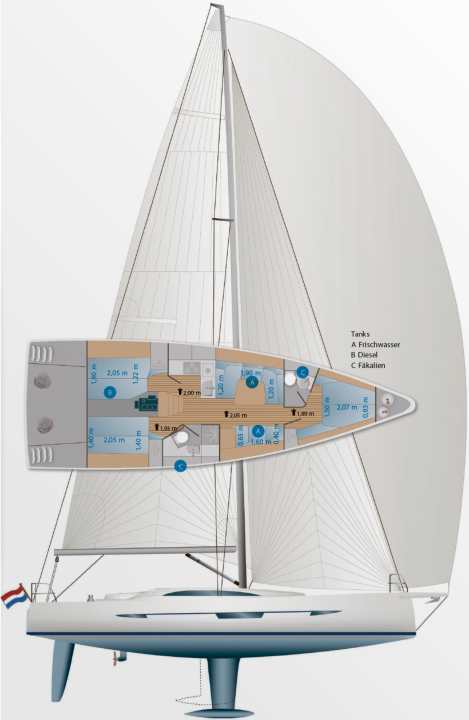
Technical data of the Saffier SL 46
- Designer: Hennevanger/Van de Stadt
- CE design category: A
- Torso length: 13,75 m
- Total length: 14,90 m
- Waterline length: 12,54 m
- Width: 4,45 m
- Draught/alternative: 2,20/2,70 m
- Mast height above WL: 22,60 m
- Theor. torso speed: 8.6 kn
- Weight: 10,9 t
- Ballast/proportion: 3,2 t/29 %
- Mainsail: 68,0 m²
- Self-tacking jib: 50,0 m²
- machine (Yanmar): 42 kW/57 hp
- Fuel tank (PVC): 250 l
- Fresh water tank (PVC): 2 x 200 litres
- Holding tank (PVC): 60 l
- Batteries: 3 x 225 AH + 1 x 100 AH
Hull and deck construction
GRP sandwich construction with foam core and vinyl ester resin, built by vacuum infusion.
Motorisation
The Yanmar 57 hp built-in diesel with Saildrive and 3-blade folding propeller (Flexofold) is standard. Upgrade to 80 hp engine optional. An electric drive would be feasible, but is not specified.
Sail included
A high-quality set of upwind mainsail and self-tacking jib (Elvström Epex) is part of the basic equipment ex shipyard. Gennaker, code zero or an overlapping genoa are optionally available at extra cost.
Comprehensive electronics
Saffier equips the SL 46 with extensive navigation electronics (B&G Nemesis) as standard. This includes large chart plotters in the cockpit and in the navigation area below deck.
Shipyard
Saffier Yachts, 1976 IJmuiden (Holland); saffieryachts.com
Distribution
- Diamond Yachts, 24235 Laboe; diamond-yachts.com
- Ultramarin, 88079 Kressbronn; ultramarin.com
Competition from the Saffier SL 46
There are few comparable boats, but there are boats of a similar type.
Arcona 465 Carbon
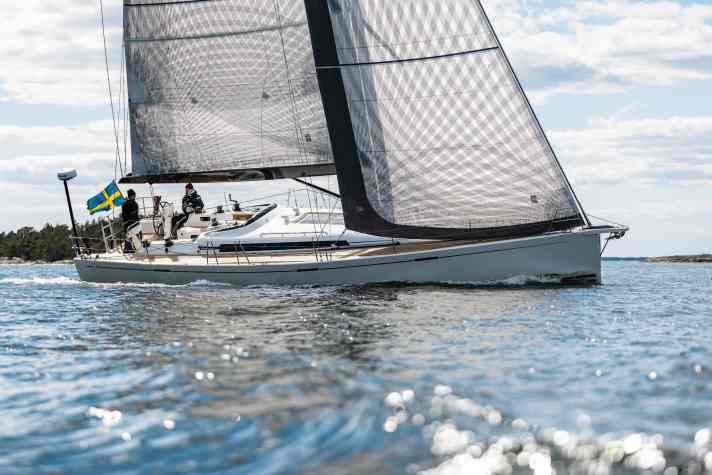
Beautiful, slim and powerful performance cruiser from Sweden. The hull and deck are made entirely of carbon fibre. The interior is finished to a high standard by hand. Length 14.09 m; width 4.24 m; weight 9.5 tonnes; from 851,415 euros.
Grand Soleil 44 Performance
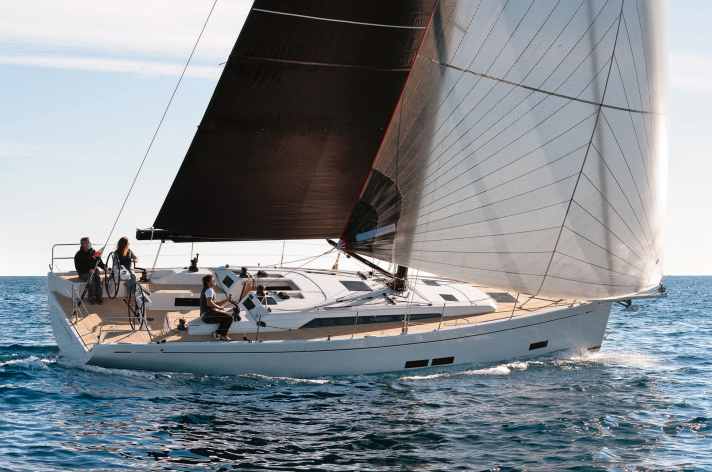
The fast Italian can be ordered in two versions: as a fast cruiser suitable for touring or as a designated racer with a sporty deck layout. Attractive price in comparison. Length 13.40 m; width 4.30 m; weight 9.5 tonnes; from 480,760 euros. Read the YACHT test here.
J/45
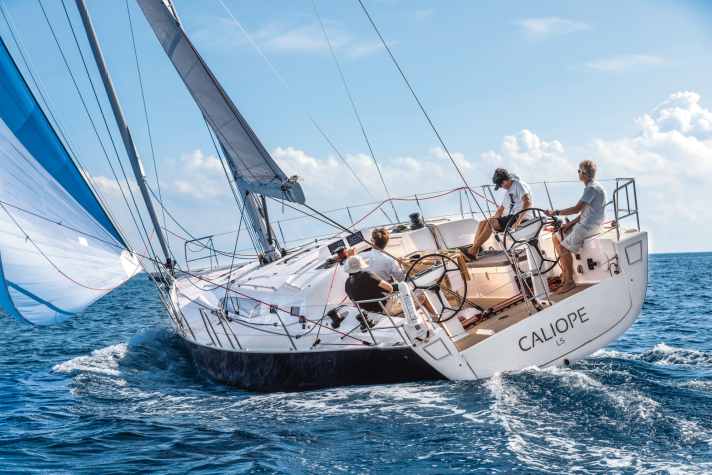
Straight and pragmatic boat from the USA, built in Europe. The pretty J/45 impresses in the test with extremely strong sailing performance. High-quality basic equipment ex shipyard. Length 13.85 m; width 4.25 m; weight 9.9 tonnes; from 612,430 euros. Read the YACHT test here.
Solaris 44
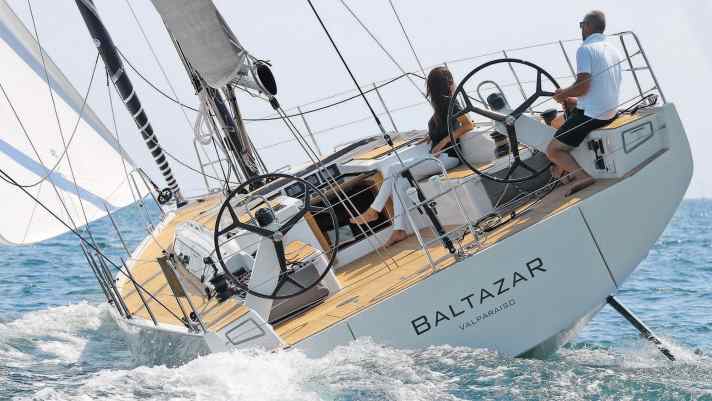
Modern design, comfortable interior fittings, high quality and good sailing characteristics to boot. With its versatile orientation, the Solaris meets a very broad demand. Length 13.35 m; width 4.18 m; weight 9.9 tonnes; from 475,880 euros.

